How to Choose the Right Sheet Metal Storage System
Options for storage, access, safety and cost
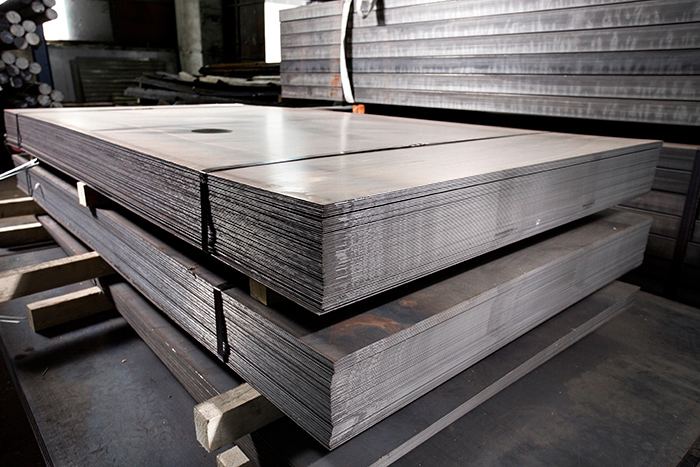
Whether you’re running a metal fabrication shop or laser cutting center, or stocking raw materials for manufacturing, sheet metal storage can make you faster. It makes the stock easier to reach, protects valuable materials and prevents injuries. However, the wrong solution means injuries, wasted time and damaged materials. In this article, I’m covering a range of solutions, from simple floor stacking to semi-automated carousels, analyzing for fit, safety, access and cost.
The challenges of sheet metal (and other sheet storage)
Sheets are large, heavy and tough to move–particularly sheet metals. They can warp, rust or scratch. They usually have dangerous sharp edges that cut and bruise people working with them. Poor storage creates bottlenecks that delay fabrication, needlessly eat floor space, endanger your people and increase work-in-process time.
Storage system selection factors
- Access volume and frequency: Do you retrieve materials multiple times per shift or just weekly?
- Space utilization and storage density: Is floor space squeezed? Can you use vertical height? How close can you keep sheets to their next step in the process?
- Handling methods and limitations: Will operators retrieve sheets manually, or with forklifts or hoists? How does that method transition sheets to the next phase?
- Size and weight factors: Are your sheets full-size? Do they vary in thickness or type? Are they too heavy for manual handling?
- Look at your workflow: Are you storing work-in-process, staging for machines or holding long-term stock? Where are the pain points?
- Safety and ergonomics: If people are handling sheets by hand, what are the injury or musculoskeletal risks?
- Costs: All manners of storage have costs. What are the most and least expensive options?
This guide compares seven storage systems to help you make the best decision for your operation. We also cover the pros and cons of simple floor stacks
Storage solutions defined
| Storage Method | Space Efficiency | Access Speed | Automation Level | Handling Equipment | Cost Range | Best Use Case |
|---|---|---|---|---|---|---|
| Vertical Sheet Racks | Medium–High | Moderate | Manual | Hand / Forklift | $ | Shops with multiple sheet types needing fast visibility and easy manual access |
| Horizontal Sheet Racks | Medium | Fast | Manual | Hand / Forklift | $ | Production areas with full-size sheet stock near the point of use |
| Roll-Out Sheet Racks | High | Fast | Manual | Forklift / Hoist | $$ | Laser/plasma stations; production machinery exposure in frequent access operations |
| Sheet Metal Carousel | Very High | Moderate | Semi-automated | Tray delivery system | $$–$$$ | Space-constrained, high-throughput operations with taller ceilings to take full advantage of the system’s space efficiency |
| Sheet Metal Stackers with Fork Pockets | Medium | Fast | Manual | Forklift | $–$$ | Work-in-process staging near laser, shear or other machines |
| Cantilever Racks | Medium | Moderate | Manual | Forklift / side-loader | $–$$ | Mixed flat and long material storage; cantilever design makes sheets accessible to forklifts or loaders |
| Pallet Racks | Low–Medium | Slow | Manual | Forklifts | $ | Low-access sheet storage or backup stock. Pallet racks can store bulk sheets, but aren’t ideal for WIP applications. Forklift access can be an issue. |
Vertical sheet racks
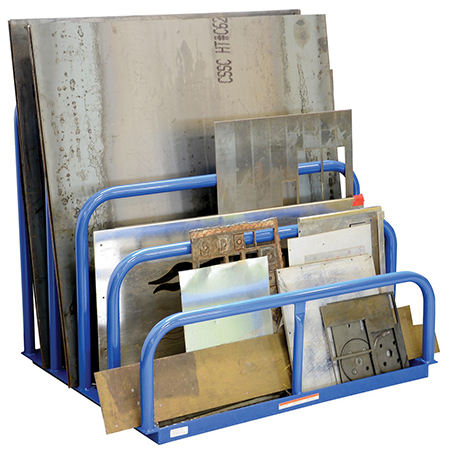
Vertical sheet racks aren’t very space efficient because they can’t take advantage of vertical space. They’re loaded and unloaded by hand, which limits the sheet types you can store in them. But they let you handle sheets closer to the point of use, bringing the material closer to the machinery. They’re extremely flexible. They store sheets upright between dividers, similar to books on a shelf, so you have the ability to easily store and access leftovers and varying sheet sizes. The material you store in a vertical rack needs to be suitable for stacking on its side without warping or bending.
- What they do right: It’s easy to sort different sheet types and sizes; you can move them around easily; it’s visually easy to see, place and pick stock.
- Cons: Manual handling can be cumbersome; they aren’t stackable for vertical storage.
- Safety and ergonomic factors: There are some tipping risks with poor loading (you can bolt them down). Moderate risk of sheet tipping or edge contact; bending and lifting can strain the lower back if not managed properly.
- Best application: Shops that deal with multiple small-lot sheet types and need fast access near point of use.
Horizontal sheet racks add economical manual storage density with limited vertical expansion
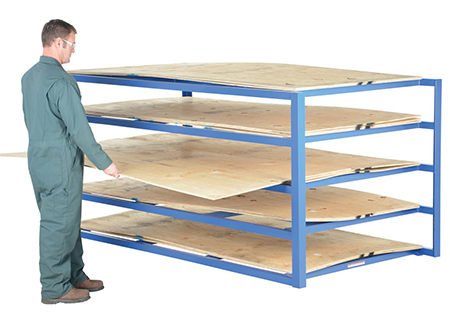
These racks store full sheets flat in horizontal bays or levels and are usually loaded/unloaded by hand. You can store maximum 2,000 pounds a shelf, which means that for heavy sheets, you can’t store that much material. However, for lighter sheets or non-metal sheets like plywood, these work well. You can access everything in the rack all the time, which means you can stack each level with a different sheet and get to it when you need to.
- What they do well: Easy manual access with some utility for forklifts; efficient for heavy, uniform sheet loads.
- The issues: Can be bulky; low vertical density unless stacked high. Each level is limited in vertical height to only 9.5″ including handling gaps.
- How safe are they? Falling sheets or improper stacking can lead to crush injuries and strains. Each sheet must be manually extracted from the rack.
- Best Use Case: Production areas where you need fast, frequent access to full-size sheets.
Roll-Out sheet metal racks provide dense, protective storage at point-of-use
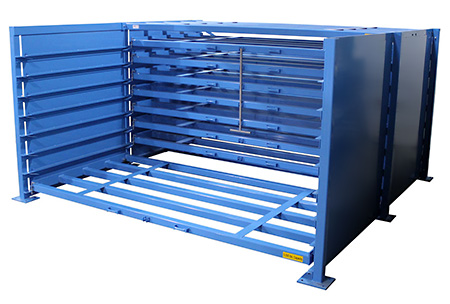
Roll-out racks are heavier and denser than most static rack options. Individual drawers or levels slide out for overhead lifting or picking, which makes access for sheet, magnetic or vacuum lifters easier, since the face of the sheet is more accessible for gripping. Can be combined with sheet stacking units for concentrated vertical storage. The roll-out system helps protect sheets, which reduces product damage and exposure. These racks excel for point of use, WIP applications where density in relation to the work area is critical.
-
- Pros: Ergonomic; avoids unstacking to access buried sheets; safe handling.
- Cons: Higher upfront cost; fixed storage volume.
- Safety and ergonomics: Excellent ergonomics; roll-out design reduces overreaching and heavy lifting; minimizes injury risk from dropped materials. Very little or no manual handling is involved, which makes handling heavy sheets safer.
- Best applications: Laser/plasma cutting stations; areas where frequent access is needed. Also available with folding doors for secure applications.
Above: Roll-out sheet metal rack with folding doors demonstration
Sheet metal handling carousels deliver sheets directly to access points

This semi-automated system rotates trays vertically to deliver materials to the operator at a comfortable height. It’s a high-efficiency, space-saving solution ideal for tight footprints and frequent access. Carousels significantly reduce lifting strain and edge contact but come at a higher initial cost and require power. Great for operations with high throughput and a strong safety focus. This isn’t an option for slower, less process-driven operations. But for the right situation, it’s ideal.
- Pros: Extremely high storage density; ergonomic; improves picking accuracy.
- Cons: Electrical/mechanical complexity; higher investment.
- Safety factors: Automated delivery reduces lifting and contact with sharp edges and delivers a sheet in perfect position for the next step. Well suited for preventing strains and cuts.
- Best use case: High-throughput operations where space is limited and ceilings allow full access to the vertical cube.
Above: Sheet metal carousel system in operation
Sheet metal stack systems allow fast, segmented forklift access to vertically stored bulk materials

How it works: Sheet bundles rest in steel cradles with forklift access slots. Stackers allow quick forklift access to bundled sheets, making them perfect for staging, WIP handling or machine feeding zones. They’re safer than loose stacking and reduce manual handling and can be combined with other options (roll-out systems, racking). Stackers are a moderate-cost, high-speed solution for shops with frequent internal material movement.
- Pros: Easy movement; ideal for staging or frequent WIP transfers. Can be stacked with slide-out racks for reserve storage capacity.
- Cons: Bulk storage at height, accessible by forklift only.
- Safety & ergonomic factors: Safer than loose stacking; forklift-only access minimizes manual handling. Some falling item risks if sheets aren’t securely banded or unevenly stacked.
- Best Use Case: Near machine centers (laser, shear, brake) for quick material rotation.
Cantilever racks let you store heavy, long and mixed sheet and other loads at height
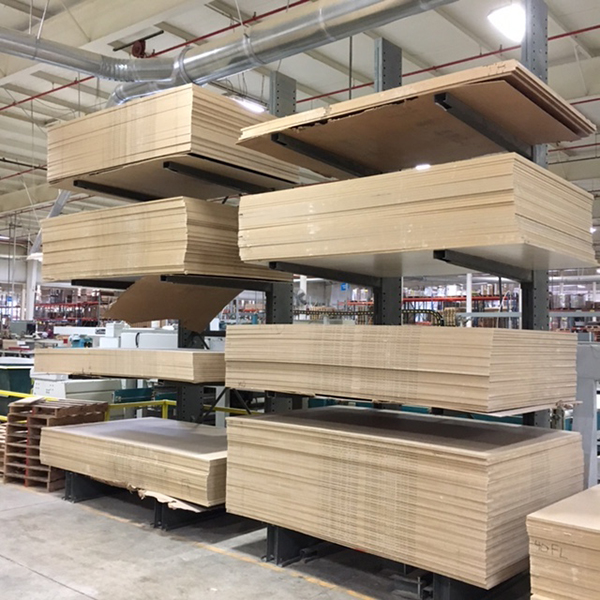
How it works: Horizontal arms extend from uprights to support flat stock or long loads. This works for any long, heavy load–which fits sheet metals or other materials in many cases. Companies that use sheets often use tubing and other materials suitable for cantilever storage. You can access lower shelves (with suitable loads) for manual access, but heavier sheets and overhead loads require forklift access.
- Pros: Highly flexible; can store a mix of sheet and bar stock. You can store a different type and dimension of sheet on each level (for instance, sheets on the lower levels and pipe on different arms above, or any other desired storage mix).
- Cons: Limited vertical stacking; open format can create access issues for small items.
- Safety & ergonomic factors: Safer than loose stacking; forklift-only access minimizes manual handling. Some risk of falling items if sheets aren’t securely banded or unevenly stacked.
- Best use case: Fabrication shops needing flexible access to mixed materials. A good solution for reserve storage.
Pallet racks allow mixed pallet, bulk and sheet storage
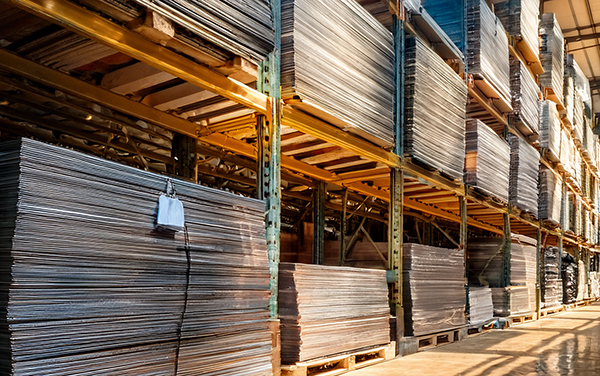
Pallet racks let you store sheet metal directly on rack structure or on pallets. You can take incoming shipments of sheets and move them directly onto a pallet position. You’ll need to ensure that your racks can carry the concentrated weight of your sheet stacks, but many types of racks can handle those types of heavy loads. Pallet racks aren’t commonly used for sheets, but do have a role in certain operations.
- Pros: Low cost; modular; already present in many warehouses.
- Cons: Not optimized for sheet handling; partial retrievals can be awkward (or impossible).
- Best Use Case: Long-term storage, bulk/reserve storage or low-access sheet stock. Good for slow movers.
What about floor stacking?
Stacking sheets on the floor is probably the most common method. It’s simple and economical, and is the way to go in many situations. Sometimes it’s all you need.
Why floor storage? It’s efficient, versatile and requires no storage infrastructure
- Floor stacking can be space efficient: It can maximize horizontal storage capacity without the need for racks. You can usually stack banded sheets high, so they can use vertical space. This approach is low-cost, as it avoids the costs of storage infrastructure.
- Direct costs are low: Your investment in a sheet storage solution can be significant, depending on volume, size of operation and available space. Stacking is essentially free.
- Versatility: Floor stacks can be positioned wherever you want them. You can mix and match positioning to suit the situation.
Why not floor storage? It’s inaccessible, has hidden costs and can be disorganized
- Access can be tricky. Retrieving specific sheets often requires moving upper layers, which can be labor-intensive and time-consuming, especially for diverse stock. If you cover up one type of sheet with others, or stack a stack of them behind others, you need to reorganize and move things around on the fly.
- Safety considerations: Structured storage, like racks, factor for load capacities and related tolerances. You’re controlling how much, how high, etc. With floor stacks, the controlling factor is often how well formed the stacks are or how well they are banded. Sheets can slide out, tip or become unstable on the floor more easily than in a controlled storage solution. What are the limits for stacking safely on the floor?
- Flexibility comes at a cost: While you can stack any stack anywhere on the floor, that can become disorganized quickly without a system. For operations that only use one size/grade of stack, that’s not as much of an issue.
- Hidden costs can add up: Although floor stacking initially saves money, the costs associated with slower retrieval times, material damage from handling and increased labor may offset those savings. You may not always know what’s in every stack, or if stacks have been mixed by different people at different times.
Scott Stone is Cisco-Eagle's Vice President of Marketing with 35 years of experience in material handling, warehousing and industrial operations. His work is published in multiple industry journals an websites on a variety of warehousing topics. He writes about automation, warehousing, safety, manufacturing and other areas of concern for industrial operations and those who operate them.



